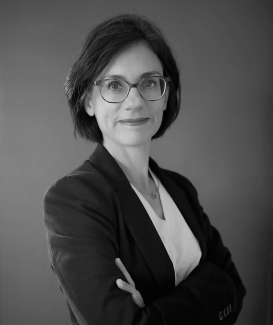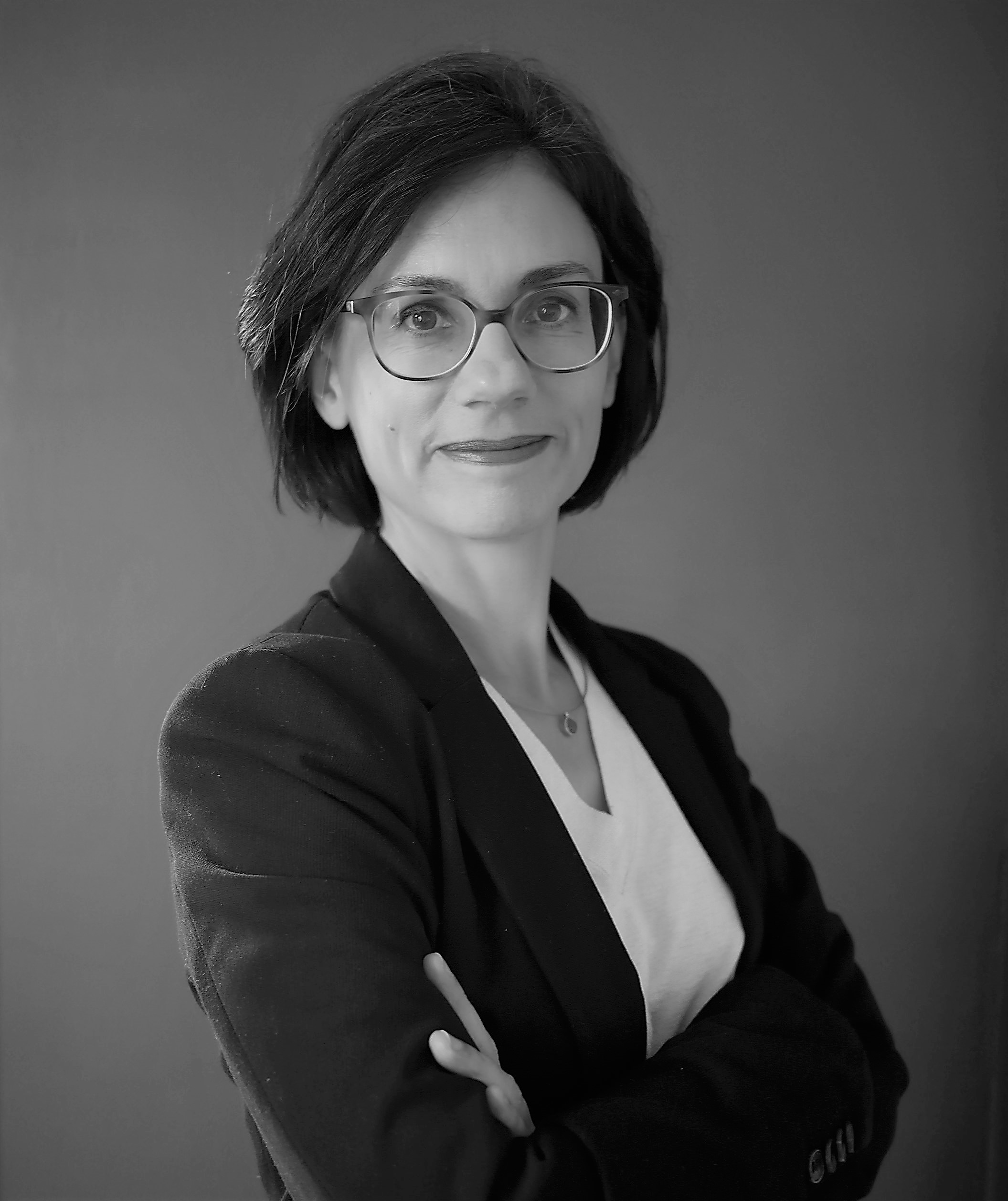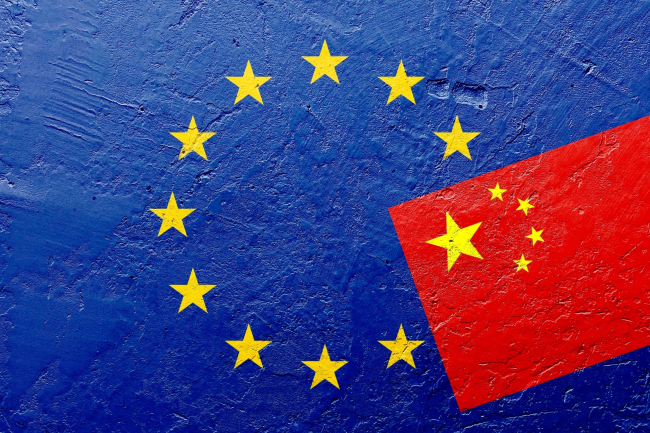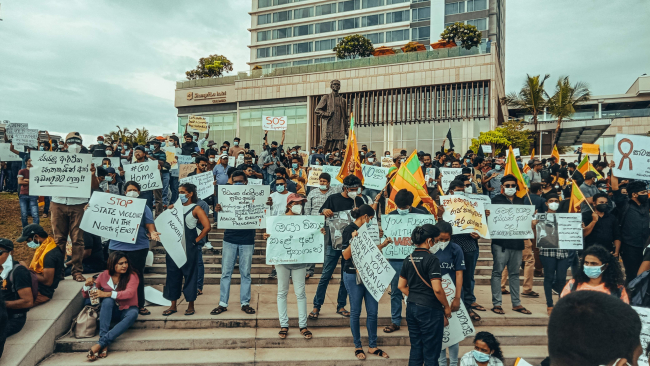Korea Looks to the Pacific: A First Cut with the 1st Korea-PIC Summit
This move surprised many Oceania watchers across the globe, as Korea seemed to have tenuous relations with these island countries focused on tuna fishing, tourism and official development assistance (ODA) projects. Their economic and political relations are much less significant compared to those between the PICs and other great and regional powers. The Korea-PICs meeting has been held five times since 2011, at foreign minister-level. This upgrade of Korea–PICs relations has been welcomed by the Pacific Island Forum (PIF) countries amid the great-power competition.
The three-day event, held in Seoul and Busan, was attended by all the 18 countries’ heads of states or top ministers, except for typhoon-hit Micronesia. President Yoon Suk-Yeol had bilateral meetings with 10 heads of state (Papua New Guinea, Vanuatu, Tuvalu, Tonga, Kiribati, Cook Islands, Marshall Islands, Solomon Islands, Niue, and Palau) and the Australian defense minister. The Korean prime minister and foreign minister met with the two presidents of the French territories of French Polynesia, New Caledonia and ministers of Samoa, Nauru, Fiji, and New Zealand. Then these top leaders were taken to Busan – a key harbor city, a marine policy headquarters, and candidate to host the 2030 World Expo – to discuss further cooperation. South Pacific participants highly praised Korea’s gracious gesture of rolling out the red carpet, showing utmost respect to the guests.
The summit yielded the “2023 Korea–PIF Leaders Declaration” and the “Korea–Pacific Islands Action Plan” as outcomes.[1] The two documents meticulously detail what Korea has to offer to the PICs in relation to three Rs: resilience (climate and disaster resilience), reinforcement (capacity-building) and revitalization (connectivity in the post-Covid-19 era). Seoul will double down on ODA (to 40 million dollars) by 2027, providing highly concessional loans, including to review the port construction project in Papua New Guinea; enforcing green energy projects in the Solomon Islands, Fiji and the Marshall Islands; strengthening the maritime security capabilities of PICs; and supporting infrastructure development and capacity-building to improve ICT connectivity.
Seoul can extract benefits from strengthening ties with the PICs, be it in terms of accessing raw materials, seeking diplomatic support in multilateral settings – the 2024-25 UN Security Council Non-Permanent Membership – or playing a leadership role in tackling climate change globally. Still, the South Pacific appears to be a challenging area for Korea, as Seoul has little political ambition or historical baggage in the region.
This momentum in ROK–PICs relations is indeed part of a strategic vision that broadens the scope of ROK’s diplomatic outreach. It contributes to the implementation of Korea’s freshly minted Strategy for a Free, Peaceful, and Prosperous Indo-Pacific Region (IPS), adopted in December 2022, which clearly supports the implementation of the 2050 Strategy for the Blue Pacific along with deeper engagement with the Partners in the Blue Pacific (PBP), an initiative by the US and like-minded partners for cooperation on Pacific Island priorities.[2]
Korea goes beyond Northeast Asia and into a big boys’ game
Korea recognizes the South Pacific as a crucial regional element within its IPS, which participates in the Yoon government’s ambitious Global Pivotal State (GPS) initiative. Korea actively engages in the Indo-Pacific region, joining the ranks of major players such as the United States, China and other influential regional powers.
Considering the growing influence of China, the United States has encouraged Korea to step up its engagement in the Indo-Pacific and provide more alternatives to Beijing’s Belt and Road initiative (BRI), along with like-minded partners. This started with Korea’s New Southern Policy (NSP) and the US’s Indo-Pacific Strategy Bilateral Factsheet in 2019.[3] The NSP was, arguably, the first successful regional strategy of Korea beyond Northeast Asia. It focused on fostering extensive and pragmatic (realpolitik) cooperation with Southeast Asia and South Asia, particularly India. This cooperation encompassed various aspects such as the economy, politics and society, and aims to be in line with what the US and other like-minded countries have achieved as part of their Indo-Pacific strategies. Despite not directly countering Chinese BRI, Korea’s increasing presence in the region exerted pressure on China’s prevailing influence.
The NSP marked a significant milestone in Korea’s diplomatic history and laid a strong foundation for the current government’s IPS and GPS. In this vein, the ROK’s follow-up action in the South Pacific is considered a strategic move on the global chessboard, reflecting the complex dynamics of the geostrategic multidimensional – military, economic, technological and environmental – security convergence and competition.[4]
China is certainly irked by Seoul’s broadening of its strategic horizon beyond the Korean peninsula. The South Pacific region is one of the critical frontlines for China to project its power beyond East Asia. Beijing has made substantial investments under the Belt and Road Initiative, thereby acquiring considerable economic and political leverage over the island nations involved. Against this backdrop, China regards Korea’s deeper engagement with the PICs, Australia and New Zealand as a proxy maneuver influenced by the US to bolster its dominance by incorporating another like-minded country into this vast ocean territory. China accuses Korea, which does not have any interest and capacity to play a role in this region, of being a “pawn” in US hands, singling out the current Yoon government as being “pro-US” and “anti-China”.
In a period when the global security structure is undergoing much change, Korea, with its advanced defense industry, has expanded its reach beyond Northeast Asia, extending even into Europe. Seoul aspires to elevate its position in the global hierarchy, given the substantial improvement in its comprehensive state capacity, which now rivals that of several upper-middle powers in Europe and Asia. Engagement with the PICs is one part of this story. Within the Korean decision-making circle and strategic community, there is a widespread consensus that Korea must actively pursue global involvement to assert and safeguard its national interests. Indeed, Korea has entered a set of big boys’ games. It is evident that Oceania, within the Indo-Pacific framework, is an important region for Korea to engage and interact with.
A welcome engagement with PICs
Korea’s presence in the region is now being welcomed by Australia and New Zealand. Initially, Canberra had reservations about Seoul’s economic engagement in the South Pacific, as it viewed it as encroaching on a market where Australia had a dominant position. It did not consider Korea as having any legitimate connection to this region, despite Korea’s expertise in vital technologies and industries that are beneficial for the islands’ economies. However, the increasing influence of China in Australia’s own backyard led to a shift in Canberra’s stance.
Canberra’s recent strained relationship with China, involving substantial economic and political sanctions, has encouraged Australia to gain the support of capable like-minded partners to constrain Beijing. Multiple Australian officials and experts have reiterated, “We are in the same boat”. Korea is Australia’s fourth largest trading partner and Australia is the eighth largest trading partner for Korea. At a time of growing geopolitical competition in the Pacific region, Korea is seen as a “natural partner” for Australia. At the side of the ROK–PICs summit, Australian Defense Minister Richard Marles met President Yoon and his top foreign policy advisers to discuss multi-dimensional security cooperation, South Pacific regional security, Foreign-Defense Ministerial 2+2, supply chains, and the defense industry. New Zealand shares a similar perspective with regards to Korea.
The Pacific Island countries welcome Korea in the region. The PICs want to hedge between the Australia–New Zealand–US triumvirate and China, and seek more capable partners with little political ambition. Korea fits this role. Even though Korea is a junior partner in the US-led hub-and-spokes alliance system, its relations with China have been critical and relatively well-managed so far. In addition, Korean aid in monetary, industrial and technological form may help the PICs to reduce their dependence on both China and the Western powers, which have recently boosted their assistance. Korea can contribute significantly to positive outcomes while causing minimal harm.
However, certain countries have voiced concerns about becoming politically entangled in this emerging cooperation. The Solomon Islands refused to sign the Joint Declaration on the ground that Korea’s IPS allegedly “targets a third country (i.e., China)”.[5] The other 15 island countries, however, were silent on this provocative balancing act by the Solomon Islands. Pacific Islanders have different perspectives in foreign interactions with outside powers, which frustrates Korea, a novice in this strategic area. It is a moment of realpolitik for Korea, which needs to deal with China outside Northeast Asia, and vice versa.
Opportunities to develop France–Korea cooperation in the Pacific
While Paris has welcomed Seoul’s growing engagement in the Indo-Pacific and Europe, Korea has not been, so far, on the radar screen as a legitimate partner in the South Pacific. New Caledonia and French Polynesia, as French territories and full members of the PIF since 2016, were invited to participate in the Korea–Pacific Islands Summit. This development led to interactions between Seoul and Paris, allowing Korea to grasp the reality of France’s presence in the Oceania region. Very positive reports[6] were issued by the French territories that could convey to Seoul their willingness to develop ties in industry (especially the digital sector), tourism, the environment and agriculture. In addition, their visits benefitted from good media exposure, broadening the possibilities of cooperation with Northeast Asian countries.
This is a first promising move. As the summit might convene on a more regular basis, it would allow Seoul to step up its regional engagement. This is also opening opportunities to develop Franco–Korean cooperation in the region. In this perspective, the French authorities encourage Seoul to open a consular representation in New Caledonia and/or French Polynesia, as well as to join multilateral initiatives led by France in the region such as the Kiwa (adaptation to climate change) or Climate Risk and Early Warning Systems (CREWS) initiatives.[7]
In the Pacific region, Korea, as a potential member of the Partners in the Blue Pacific, is expected to move in tandem with the United States, Australia and New Zealand. This said, Seoul is also wary of not antagonizing China, to the extent that its Indo-Pacific vision labels Beijing as a partner. This positioning aligns closely with that of France and should serve as an asset for advancing cooperation between Seoul and Paris in the Pacific.
[1]. These documents are listed at: www.president.go.kr
[2]. Korean Presidential Office, “The Strategy for a Free, Peaceful, and Prosperous Indo-Pacific Region”, p. 19. www.mofa.go.kr
[3]. See the website of the US Embassy in Korea, www.kr.usembassy.gov
[4]. W. Paik, “Korea Looks to Europe: Its Growing Military-Strategic Cooperation with NATO”, IDSP Issue Brief (05/2023), www.isdp.eu
[5]. See the website of the Solomon Islands Government: www.mfaet.gov.sb
[6]. See, for example, in French: T. Waïa, C. Lindor, F. Tromeur, « La Nouvelle-Calédonie au sommet entre la Corée du Sud et les îles du Pacifique », Nouvelle Calédonie La Première, May 30, 2023 ; www.la1ere.francetvinfo.fr
[7]. See the websites for details: www.kiwainitiative.org/en; www.crews-initiative.org

Available in:
Regions and themes
ISBN / ISSN
Share
Download the full analysis
This page contains only a summary of our work. If you would like to have access to all the information from our research on the subject, you can download the full version in PDF format.
Korea Looks to the Pacific: A First Cut with the 1st Korea-PIC Summit
Related centers and programs
Discover our other research centers and programsFind out more
Discover all our analyses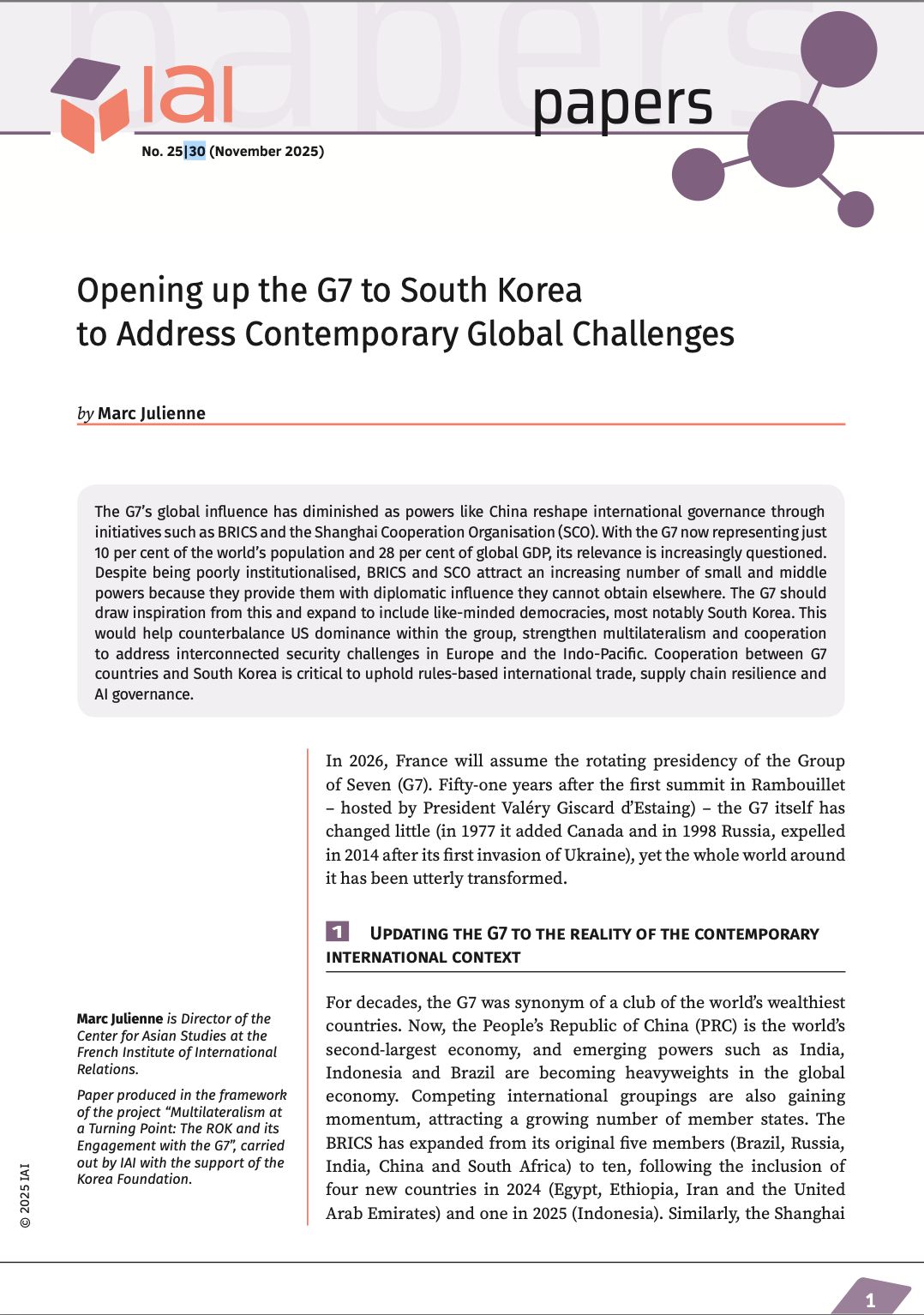
Opening up the G7 to South Korea to Address Contemporary Global Challenges
The G7’s global influence has diminished as powers like China reshape international governance through initiatives such as BRICS and the Shanghai Cooperation Organisation (SCO). With the G7 now representing just 10 per cent of the world’s population and 28 per cent of global GDP, its relevance is increasingly questioned.
Expanding SPDMM as a pivotal institution in the Pacific – A French perspective
The South Pacific Defence Ministers’ Meeting (SPDMM) is the only forum that brings together defense ministers from the wider South Pacific — including Chile, which is hosting it for the first time. This heterogeneous group of countries with varying resources, capacities, and interests — Australia, Chile, Fiji, France, New Zealand, Papua New Guinea (PNG), and Tonga — are united by their shared determination to strengthen cooperation on maritime security and humanitarian assistance and disaster relief (HADR) activities.
EU’s Derisking From China: A Daunting Task
With economic security as a major concern, the EU has recently turned to “derisking” from China. The EU strategy entails reducing critical dependencies and vulnerabilities, including in EU supply chains, and diversifying where necessary, while recognizing the importance and need to maintain open channels of communication.
Sri Lanka’s NPP Government. From System Change to Structural Compliance
In September 2024, a relative outsider to Sri Lanka’s two-party-dominated political system, Anura Kumara Dissanayake, won the presidential elections. The anti-establishment, populist movement he represented, the National People’s Power (NPP), went on to receive an overwhelming mandate in the November 2024 general elections, winning 159 seats in a 225-member parliament.





